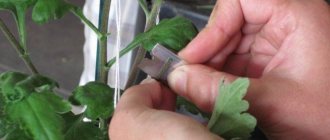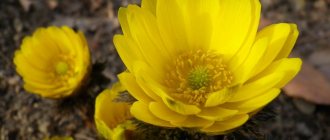Myrtle (Myrtus) - Growing, care, reproduction.
Myrtle (Myrtus) is an ornamental shrub from the Myrtaceae , native to the Mediterranean.
In nature, this beautiful shrub with leathery leaves is widespread in the subtropics, where there are about 70 different species. It is noteworthy that the fruits of many myrtles are edible. This plant is shrouded in many myths and beliefs; it is believed that myrtle helps preserve beauty and youth, and to do this, just pick a leaf of this magical shrub while passing by. If you have a long journey ahead, do not be lazy to take a sprig of myrtle with you on the road; many believe that it can strengthen the traveler’s strength, give vigor and endurance.
The name of the genus comes from Greek and means “myrrh”, “balm”. Myrtle has a truly rich history, which dates back to the times of Ancient Rome and Greece, where it was planted in groves next to the temples of Venus. There is a belief that this plant is the only one that has taken root from the Garden of Eden on earth; it was brought and planted by Adam himself, in memory of Eden, and raised as a hope of return, which is why it is sometimes also called “Adam’s tree.”
Myrtle began to be cultivated a very long time ago, about 400 years ago. In nature, this shrub can reach up to 5 meters in height, but at home it can rarely be grown to 1 meter. In the climatic conditions of Russia and Ukraine, myrtle is grown only in greenhouses, apartments and winter gardens.
This plant is very useful for home cultivation, since the phytoncides secreted by myrtle cleanse the air of microbes, viruses, fungi and help cope with respiratory diseases. It is noteworthy that myrtle is hypoallergenic.
Kinds
Common myrtle (Myrtus communis)
In home floriculture, the most commonly grown myrtle (Myrtus communis) has a short branched trunk covered with exfoliating scales of red-brown bark. The leaves are green, oval-lanceolate, glossy, leathery, with a pleasant aroma. The flowers are white or pale pink with prominent stamens, the fruits are red-black berries. Blooms from June to August. Popular cultivars: “Tarentina” - a compact bush with berries that are smaller than those of the original form, but there are significantly more of them than those of the common myrtle; The variegated variety has a creamy-white pattern on green leaves.
Lush myrtle (Myrtus apiculata)
Also interesting is the lush myrtle (Myrtus apiculata) - a bush or tree with peeling brown bark, under which the trunk is creamy white. The leaves are dark green, elliptical, matte. White single flowers bloom in July-August, black-red fruits are edible.
Myrtus chequen
Tree with shiny green leaves with wrinkled edges. This species is the most resilient of the myrtles.
Ralph's myrtle (Myrtus ralfii)
An erect bush with pinkish flowers and red edible berries. It is a variegated variety with a white-cream border around the edges of the leaves.
About caring for myrtle:
Temperature: Myrtle grows and develops well at normal room temperatures of 18-20°C. The difficulty of growing myrtle in apartment conditions is that it needs a cool winter; the temperature in winter should be lowered to 8-10°C.
Lighting: The plant prefers well-lit places with access to fresh air, but without direct sunlight, which has a detrimental effect on its decorative effect. The best option for myrtle would be eastern and western windows; avoid placement on southern window sills. You should also not place myrtle on northern window sills, where it may encounter a lack of lighting. In winter, try to provide the shrub with plenty of light, which will make the myrtle’s dormant period shorter and more prosperous, and in the summer, the myrtle will not refuse to be placed in the garden, in the shade of trees, but keep in mind that the moving procedure must be carried out as carefully as possible, since the shrub does not like rearrangement from place to place.
Watering: The main thing in watering myrtle is to constantly maintain moist soil in the pot, without stagnation of excess moisture in the pan. In summer, watering is carried out immediately after the top layer of soil has dried; in winter, watering is carried out less frequently, but without allowing severe drought. Watering is carried out only with warm soft water.
Air humidity: The shrub loves moist air and regular spraying in the summer, excluding the dormant period. In winter, it is very important not to keep the plant near heating devices.
Fertilizers : Apply weekly during the entire growth period except the dormant period. Fertilizer should be focused on nitrogen and phosphorus.
Soil: Take a universal substrate to which humus is added for nutritional value. Vermiculite will not be superfluous. A thick layer of drainage is required at the bottom of the pot.
Transplantation: Carry out in the spring, young myrtle bushes are replanted annually, it is not advisable to disturb adults more than once every 2-3 years. An important rule when replanting is not to deepen the root collar of myrtle; try to maintain the level of deepening. Do not take too large a pot at once, increase it gradually.
Pests: Myrtle is susceptible to pests, so for prevention it is advisable to regularly spray it with a special solution against pests.
Can I keep it at home?
If you brought myrtle home, you need to choose the right place for it. It will depend on the season.
In summer, you should place the flower pot on the balcony or in the garden. This is the most favorable place. You just need to make sure that the plant is not exposed to sunlight for long. In winter, myrtle should be moved to sunny areas. Room temperature is quite suitable for him during the cold period.
The plant should be in the bedroom. He doesn't really like attention from strangers.
Myrtle is a very amazing plant. Its flowers not only have a wonderful aroma, but also have medicinal properties. Even a small plant will help cope with viruses and diseases in the house . Myrtle oil has many indications for use and is therefore highly valued among the people.
Myrtle tinctures give a person energy and vigor. The leaves of the plant are boiled and used to treat gastrointestinal diseases.
Miter is also used in cooking. Quite often, its leaves and stems are added to fish or poultry dishes. This unusual seasoning is also suitable for barbecue. The aroma of the dish will be amazing. Some peoples make bouquets and wreaths from myrtle for weddings. Because he personifies a friendly and strong family.
Forming a myrtle crown at home:
Myrtle lends itself well to shaping, but the main thing in this matter is regularity and caution, since if you prune too much, you can lose flowering. Careful pinching and pruning will allow you to achieve branching and lush bushes. The procedure is carried out before the start of active growth - in the spring by shortening all the growth of the previous year, leaving 3-4 buds on them. If you want to get a shrub, you need to trim the top of the tree, but if you want to grow a lush tree, trim only the side branches.
Myrtle propagation:
Myrtle successfully propagates both by seeds and cuttings.
When cutting, you need to choose semi-lignified branches from 5 cm to 8 cm long and cut all the leaves in half to reduce the area of moisture evaporation. The cuttings are planted in the ground to a depth of 2-3 cm, having previously been treated with a root formation stimulator, and be sure to set up a greenhouse from a jar or bag. The cutting is placed in a well-lit place. The greenhouse must be ventilated regularly. Usually 2-3 weeks are enough for rooting if all temperature conditions are met.
To propagate by seeds, it is necessary to use soil that contains vermiculite, which will protect the seeds from rotting. Myrtle seeds are laid out on the surface of the soil, sprinkled with a thin layer of soil and covered with a greenhouse, which is regularly ventilated. The optimal temperature for germination is 18-20°C. On average, seedlings appear in 1-2 weeks. New myrtles are transplanted when 2-3 adult leaves appear. Myrtle obtained from seeds blooms, unfortunately, only in the 5th year of life.
Seed selection
The rules are simple:
- pay attention to form and integrity;
- only proven manufacturers. There are dozens of reviews and forums on this topic on the Internet. I personally recommend: “Healing Aura” and “Hymen”;
- check the expiration date.
Old seeds can be “revived”:
- add water, stir, leave for 5 minutes. Discard any floating seeds;
- those that have passed the test, soak in a solution of potassium permanganate (5 grams of powder per 1 liter of water) for 20 minutes for disinfection;
- plant immediately after treatment.
Reproduction by cuttings
Many flower growers are interested in such a legendary and exotic plant as myrtle: propagation at home by cuttings will allow you not to throw away all the cut shoots, but to give one of them a chance to live.
It is very easy to propagate myrtle.
Spring and summer are ideal for propagating myrtle from cuttings. May and August are best suited for this purpose, but the procedure can be carried out in other months. In warm weather, the cuttings will quickly take root and grow. But in the fall, when it quickly gets colder, the branches have no chance of rooting, so at this time of year you cannot propagate plants by cuttings. Winter plantings are not for tropical trees.
Attention! A tree such as myrtle will require a careful and responsible attitude: propagation by cuttings is carried out immediately after the planned pruning of its crown.
Where to get cuttings from and how to prepare them:
- Disinfect garden shears or pruning shears to avoid introducing infection into the plant.
- Cut off a strong, healthy shoot. You can cut off both green and woody shoots. But we must remember that green branches take root faster.
- Separate a cutting 12–15 cm long from it and remove the leaves from its lower half.
- It is advisable to plant the branch immediately because it can be stored for no longer than 24 hours. To do this, wrap it in a damp cloth.
- Myrtle cuttings are treated with a root growth stimulator. You can put it in water in which this drug is dissolved for several hours.
- Place drainage: pour perlite and vermiculite into the bottom of the pot or box. You will need a pot with a drainage hole to prevent water from pooling near the roots.
- Prepare the substrate: mix turf (30%), humus (20%), peat (30%) and sand (20%). If this is not possible, use greenhouse soil.
- The soil is watered generously with water, which must first be left to settle for 24 hours.
- The cuttings are carefully inserted into the ground to a depth of 3 cm.
- The soil is compacted.
- The top of the seedlings is covered with glass or a plastic bottle with the neck cut off.
- The box is placed in a warm place, protected from sunlight and bright light.
- Once a day, the greenhouse is removed and the myrtle is allowed to ventilate.
- It is necessary to carefully observe how the young myrtle grows: rooting of cuttings occurs within 1 month.
There is an alternative way to root myrtle. To do this, place the cuttings in water closer to the heat source (battery, heater). It will take root in 1.5 months.
Attention! After the young tree grows a root, it needs to be transplanted to a permanent place - in a spacious pot.
Step-by-step instructions for transplantation:
- Rubble, broken brick or pebbles are poured into the bottom of the tub.
- Expanded clay or other fine drainage is laid on top as a second layer.
- Prepare a new substrate: mix deciduous soil, vermicompost and perlite.
- Place the seedling vertically in the soil and sprinkle the root collar with soil.
- Water the soil with plenty of water. If it settles, you need to add a little more soil and water again.
- Excess liquid must be drained and the condition of the drainage hole in the bottom checked.
- Cover the top with vermiculite.
The young sprout needs excellent care
In 2–3 years, the young myrtle tree will bloom.
Transplanting a myrtle tree
A young myrtle tree should be replanted at least once a year. An adult plant can be replanted every three years. The transplant should be done in the spring. The container for the flower must be selected with a wide drainage hole.
It is better to purchase a substrate for myrtle in a store . When replanting, its roots should be freed from the soil from the old pot and placed in a new one. The trunk of the tree itself should not be buried in the ground, because the myrtle may become diseased. At the end of transplanting, it should be watered and sprayed.
This video shows the process of transplanting myrtle:
Propagation by seeds
Unlike cuttings, when propagated by seeds, the new plant will not retain the qualities and even varietal characteristics of the mother bush. Growing from seeds will require a lot of work and time, but may not be successful because not all of them will germinate.
It is necessary to choose seeds no older than 1 year, because over time they lose their quality and may not germinate. You can buy myrtle seeds in the store or get them from the berries of a mature tree.
In order for them to actively germinate, they are stratified. This is done in winter - in January or February:
- Heat the sand over a fire or pour it with a solution of potassium permanganate, and then treat it with fungicides.
- Soak the seeds for 24 hours in a glass with potassium permanganate.
- Pour wet sand and seeds into a small box or bag, mix them and put them in the refrigerator for 2 months. They must be there at a temperature of 0..+4 °C.
- Sometimes they are ventilated on the windowsill. You can keep the mixture in the refrigerator at night and put it in an open place during the day.
Additional Information! Vermiculite can be used instead of sand.
Seeds that have undergone stratification can be sown in the soil in March or April. This is how this plant reproduces in the wild.
How to propagate myrtle by seeds:
- Prepare soil from peat, humus, sand and turf.
- Sow the seeds and cover them with a thin layer of soil (the thickness should be about 1–2 cm).
- Cover with glass or transparent plastic film and place on the windowsill. It is advisable that the temperature in the room be maintained at least +20..+25 °C.
- Once every 1-2 days the box should be opened for ventilation.
- Seedlings that have grown 2 leaves must be pruned. Each plant is planted in a separate small pot. The top of the seedling must be pinched so that the crown grows thickly.
The seedlings are transplanted into large pots after 1–1.5 months. They are carefully removed from the containers and, together with the earthen lump, are transferred to new boxes. Then you need to add a little more soil.
Myrtle will bloom only in the 5th year after sowing. Long-awaited white flowers will appear on the branches.
Skilled gardeners know how to propagate myrtle from seeds and can grow a tree from a tiny seed.
Picking
When the seedlings form two true leaves, they can be planted in separate pots for the full development of the root system. When it completely fills the volume of the pot, transplant it into a permanent container. The plants will spend the first year of life in it. After picking, seedlings may stop developing for a while - young bushes spend this period taking root in a new place. With proper care, their growth quickly resumes. As a rule, a year after germination, the size of such myrtle is about 15 cm.
When replanting, it is important to try to maintain the same level of deepening of the bush. Otherwise, this may cause rotting of the root collar.
Reproduction difficulties
With any method of reproduction, young shoots require good care. Every year they are transplanted into a larger container. Each new pot should be 3.5 cm wider and deeper than the old one. Transplantation is done in early spring, in February or March, before the myrtle has bloomed. The width of a pot suitable for a more mature plant can be easily measured: it should be 2 times smaller than the diameter of the tree crown.
Starting from the second year after planting, myrtle needs pruning. It is necessary not only to remove dried, damaged, diseased shoots, but also to form a bush. Heavy pruning will help rejuvenate the tree. All myrtles need to be pruned, regardless of their height. At home, they rarely grow above 2 meters. It is advisable to trim the crown in the spring. You cannot prune and replant in a row; you must wait a while.
Very often, gardeners encounter problems when propagating this plant. Myrtle leaves may turn yellow, dry out, or fall off. The branches also sometimes wither. The reason for this is too dry winter air. To help the tree, it is sprayed with a solution of a growth stimulator and a greenhouse is made - covered with plastic or glassware. Dried parts of the myrtle must be removed.
Young plant after transplantation
Propagating myrtle is quite simple and easy. It won't take much time or effort. The result will delight the gardener: these plants purify the air and bloom incredibly beautifully. It is not without reason that in the culture of many nations, myrtle is considered a sacred tree, a symbol of love and purity. Many people believe that this tree brings peace and prosperity to the home.
Diseases and pests
Pay attention to the leaves:
- there is not enough light - they are faded and small;
- direct rays of the sun turn yellow and curl;
- too warm - they fly around;
- the earth is dry - they fall. Cut the stems by half and moisten. After 2 weeks, growth will resume.
Due to the thick hair, myrtle can harbor pests. Do not miss:
- spider mites - difficult to find due to their tiny size. Inspect the bush regularly for white spots and thin cobwebs on the back of the leaves. For example, Sunmite and Omite are suitable for fighting;
- aphids - look for small greenish or whitish insects. Confidor Maxi or Aktara will help;
- scale insect - small shells appear on the trunk and leaves. Wipe with soapy water 2 times a week until it disappears completely.











